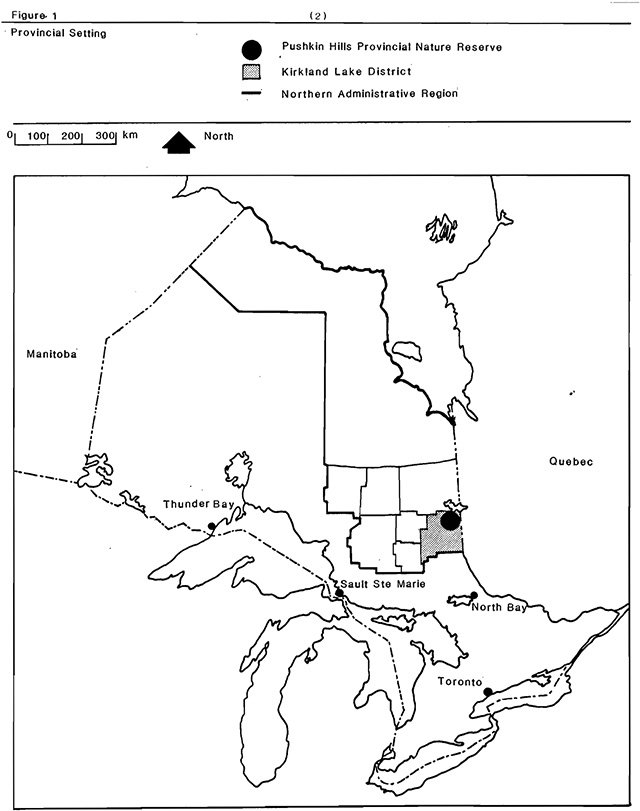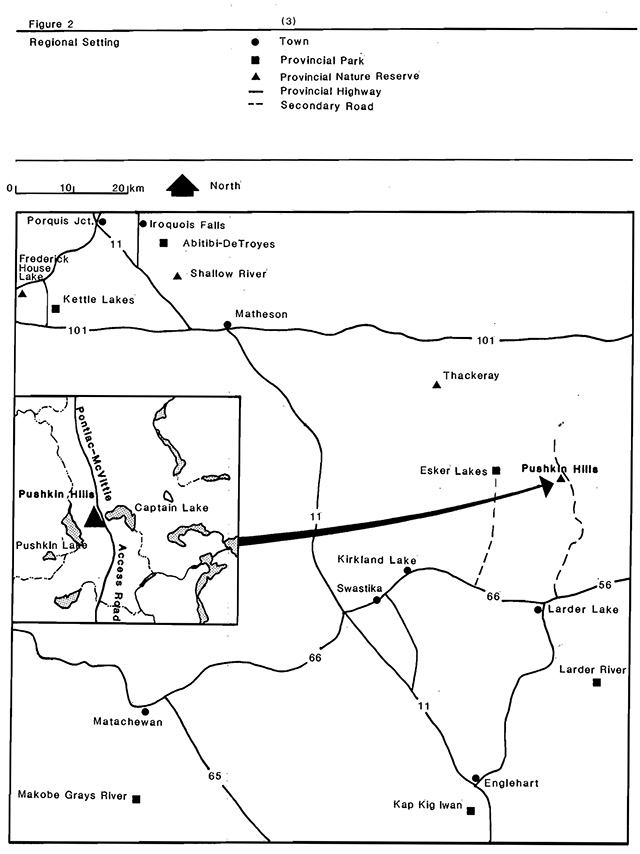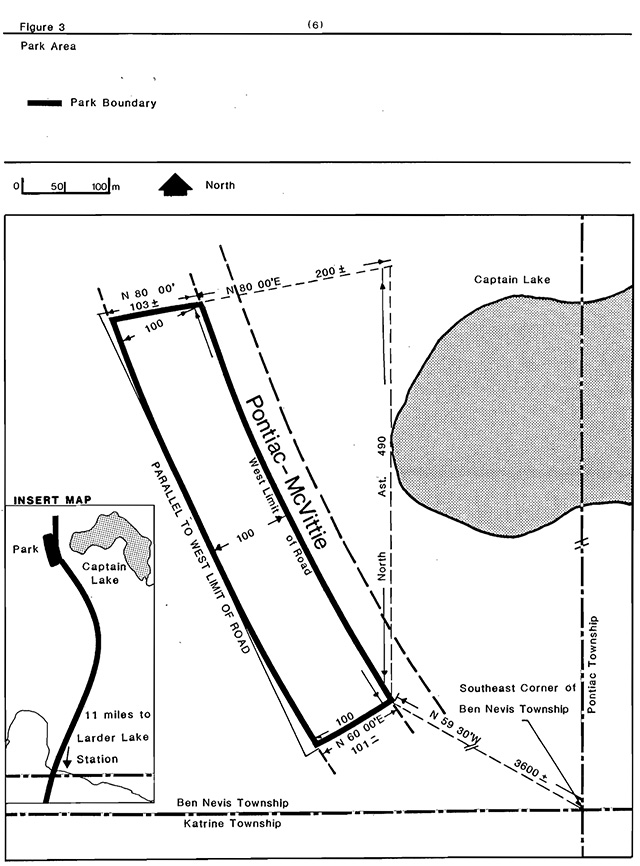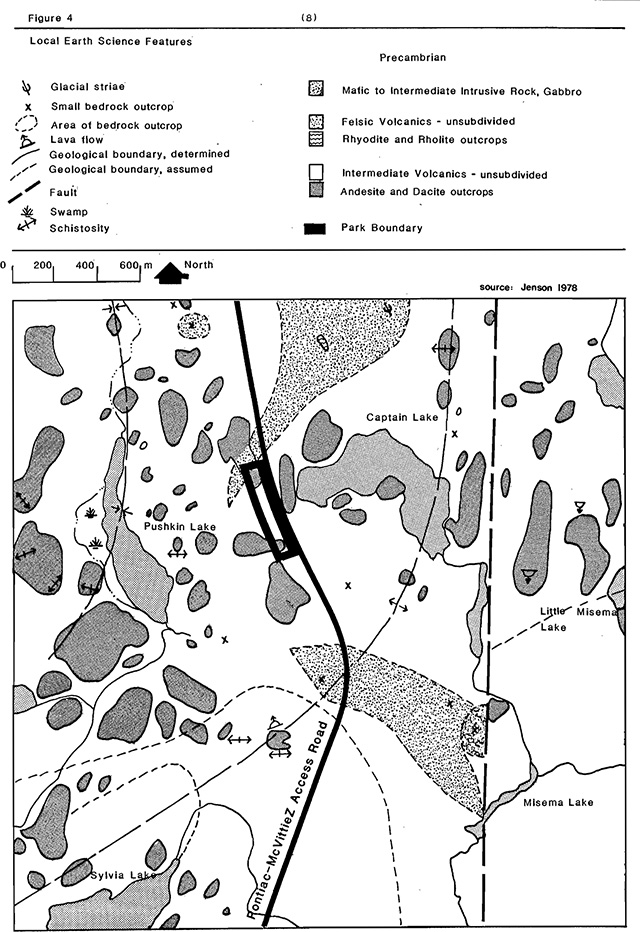Pushkin Hills Provincial Park Management Plan
This document provides policy direction for the protection, development and management of Pushkin Hills Provincial Park and its resources.
Management Plan
©1988, Queen’s Printer for Ontario
Additional copies of this publication are obtainable from:
Ministry of Natural Resources
Kirkland Lake District
P.O. Box 129
Swastika, Ontario
P0K 1T0
(705) 642-3222
Approval statement
Pushkin Hills Provincial Nature Reserve provides protection and representation of provincially significant bedrock geology, representing the youngest part of a major volcanic cycle of the central Abitibi Subprovince of the Precambrian Shield. It contains outstanding examples of pumice lava, well preserved despite their age.
We are pleased to approve the Pushkin Hills Provincial Nature Reserve Management Plan, as official policy tor the management and development of this park. The plan reflects this Ministry’s intent to protect natural features of Pushkin Hills and to provide high quality opportunities tor heritage appreciation for both residents of Ontario and visitors to the Province.
Signed by:
R.A. Riley
Regional Director
Northern Region
Signed by:
N.R. Richards
Director
Parks and Recreational Areas Branch
Compte rendu sur la réserve naturelle Pushkin Hills
Ce pare protège un fond rocheux d'importance provinciale constitue de roches volcaniques des catégories intermédiaires a felsites dans la partie supérieure calc-alcaline du groupe de la rivière Blake, qui est la plus récente du cycle volcanique de la sous-province centrale Abitibi du bouclier pré-cambrien. La réserve naturelle Pushkin Hills contribue à la protection et a l'appréciation du patrimoine naturel de la région, deux des quatre objectifs du réseau de pares provinciaux. Elle a d'ailleurs été établie pour "protéger des caractéristiques spéciales d'importance provinciale qui témoignent de la vie terrestre en Ontario" et "pour offrir des possibilités d'exploration et d'appréciation de la terre et des sciences de la vie en Ontario".
aLa réserve naturelle Pushkin Hills couvre une superficie de 5 hectares et est située dans le canton de Ben Nevis, a 24 kilometres au nord de l'autoroute 66, le long du chemin d'accès de la foret Pontiac-McVittie, dans le district de Kirkland Lake.
Les quatre problèmes d'importance pour la réserve sont la chasse, le piégeage, la prospection minière et la destruction de la végétation. La chasse est interdite dans la réserve depuis le ler Janvier 1989: le piégeage y sera interdit sous peu: les droits miniers y seront périmes et l'exploitation forestière y est interdite. Les commentaires du public ont porté sur l'emplacement du pare, l'utilisation permise des ressources et la perte de sois pour la prospection minière. L'importance de la délimitation de la réserve naturelles a été soulignée lors du processus de consultation publique.
Peu de travaux d'aménagement seront effectués au pare. En fait l'aménagement se limitera à la signalisation indiquant le nom de la réserve, les caractéristiques qui y sont protégées légalement et l'interdiction d'y chasser, d'y piéger et d'en rapporter du matériel. Il n'y aura pas de renseignements sur des ressources en particulier pour éviter que des ressources soient endommagées si des pancartes y sont apposées.
Les priorités suivantes seront entreprises selon les fonds disponibles :placer des pancartes; informer les chasseurs de la région sur l'interdiction de chasser et, sous peu, de piéger dans la réserve; établir les limites de la réserve à l'aide de bornes: produire de la documentation disponible au pare Esker Lakes; produire une brochure interprétative sur les ressources géologiques de la réserve.
1.0 Introduction
Pushkin Hills Provincial Nature Reserve is a 5 hectare nature reserve class provincial park located approximately 100 kilometres northeast of the Town of Kirkland Lake and approximately 600 kilometres north of Toronto (Figure 1). The park is located in Ben Nevis Township, 24 kilometres north of Highway 66, along the Pontiac-McVittie Forest Access Road (Figures 2 and 3). It is located in Kirkland Lake District of the Ontario Ministry of Natural Resources' Northern Administrative Region.
Pushkin Hills Provincial Nature Reserve was recommended for provincial park status in the 1983 Kirkland Lake District Land Use Guidelines. This site was originally identified as the Ben Nevis Township candidate provincial park. It was regulated on January 28, 1985 (Ontario Regulation 279/85). The mineral and surface rights were withdrawn under Order No. N.R.W. 71/83, Section 36 of the Mining Act (R.S.O. 1980).
The park provides protection and representation of provincially significant bedrock geology consisting of intermediate to felsic volcanic rocks of the upper part of the calc-alkalic Blake River Group, which represent the youngest part of a major volcanic cycle of the central Abitibi Subprovince of the Precambrian Shield. Additionally, the park contains outstanding examples of pumice lava, which are well preserved despite their age.
Figure 1: Provincial setting

Enlarge figure 1 provincial settings map
2.0 Classification
The Ontario Provincial Parks system includes six classes of provincial parks including wilderness, nature reserve, historical, natural environment, waterway and recreational. Pushkin Hills Provincial Nature Reserve is classified as a nature reserve class provincial park.
The nature reserve classification is designed to protect those unique and representative biophysical features in Ontario worthy of protection tor their natural values. Nature reserves are designated where representation of significant earth and life science features does not occur elsewhere in the provincial parks system and where the incorporation of isolated or specialized environments is necessary.

Enlarge figure 2 regional settings map
3.0 Goal
The goal of provincial parks is to provide a variety of outdoor recreation opportunities and to protect provincially significant natural and cultural environments in a system of provincial parks. The protection component is fundamental to the nature reserve classification.
The goal of Pushkin Hills Provincial Nature Reserve is to protect a provincially significant example of intermediate to felsic volcanic rocks of the calc-alkalic Blake River Group and an outstanding example of pumice lava, while providing on-site opportunities tor controlled scientific research, interpretation and education.
4.0 Objectives
Of the four objectives of the provincial parks system: protection, recreation, heritage appreciation and tourism, Pushkin Hills Provincial Nature Reserve will contribute towards the achievement of the protection and heritage appreciation objectives.
4.1 Protection objective
Pushkin Hills Provincial Nature Reserve provides protection of a provincially significant sure of intermediate to felsic volcanic rocks of the upper part of the calc-alkalic Blake River Group, which forms the youngest part of a major volcanic cycle of the central Abitibi Subprovince of the Precambrian Shield. In addition, it is an outstanding example of Early Precambrian pumice lavas (Jensen 1978).
4.2 Heritage appreciation objective
Pushkin Hills Provincial Nature Reserve will provide a resource base for scientific research, interpretation and public education of Precambrian volcanic processes. The features for which the park was established will be incorporated into the interpretive program of nearby Esker Lakes Provincial Park.
5.0 Zoning
Pushkin Hills utilizes a nature reserve zone. An access zone is not required, given ease of pedestrian access from the adjacent Pontiac McVittie Road.
This zone encompasses the entire park area (5 hectares) to include those bedrock features which contribute to the park’s significance. Jensen (1978) describes the site rocks in detail (Figure 4):
"white to light grey calc-alkalic dacite to andesite pumice flows and lava flows containing irregularly shaped pillows. The pumice flows are massive and fragmental, containing rounded, irregular shaped masses of highly pumiceous rock, densely amydaloidal. Amygdules in the massive and pillowed flows are more than 2.5 centimetres in diameter."
While the site is relatively resilient to most forms of human impact, alteration or unauthorized removal of natural features is prohibited.

Enlarge figure 3 park area map
6.0 Resource management policies
The park will be managed in accordance with the general planning and management policies for nature reserve class provincial parks (Ontario Provincial Parks Planning and Management Policies 1978). These management guidelines serve to ensure the natural integrity of the park, while permitting low-key scientific and educational use. Special direction is provided below to meet the specific geological resource requirements of Pushkin Hills Provincial Nature Reserve.
6.1 Wildlife management
Pushkin Hills is located within active trapline KL-70. Provincial parks policy states that commercial trapping licences will be phased out in a manner least harmful to the economic well being of existing trappers. The park area of 5 hectares occupies a relatively small portion of the total trapline area and withdrawal of this rock outcrop will not significantly affect trapping activity.
The park area will be withdrawn from that portion of the trapping licence upon annual renewal of the licence in October 1990.
Hunting will be prohibited in the park area on January 1, 1989. Park signs and Ministry of Natural Resources hunting information will indicate this restriction.
6.2 Mineral activity
Mineral and surface rights were withdrawn in 1983. Mineral exploration and extraction is prohibited in the park, including mineral activity originating from outside the park boundaries. Consultation will continue with the Ministry of Northern Development and Mines to ensure this restriction.
6.3 Vegetation management
Commercial timber extraction is prohibited within the park. Minor vegetative clearing may be undertaken to enhance exposure and interpretation of geological features.

Enlarge figure 4 local earth science features map
7.0 Operations policies
7.1 Visitor services
As identified in the Northern Region Visitor services Strategy, the basic thrust of visitor services programming tor Pushkin Hills Provincial Nature Reserve will focus upon the interesting geology of the park. No on-site interpretive displays are planned tor the park within the term of this plan. A low key interpretive program at nearby Esker Lakes Provincial Park will emphasize:
- the significance of this representation of intermediate to felsic volcanic rocks of the calc-alkalic Blake River Group, as well as outstanding examples of pumice lavas
- the philosophy and objectives of the provincial nature reserve system
Basic information about Pushkin Hills Provincial Nature Reserve and nearby Thackeray Provincial Nature Reserve will be produced. Appreciation of the park’s earth science features requires a fair level of geological knowledge,· with the client group likely to consist of geologists and students. A small leaflet providing information regarding access, the park’s significance, references and text should be adequate. The publication will stress the protection emphasis to prospective visitors.
7.2 Research
Scientific research and education will be encouraged. Research will be conducted with the written approval of the Ontario Ministry of Natural Resources and in accordance with the policies guiding research in provincial parks. Requests will be screened and monitored for any negative impact upon the park resource. Although the earth science features are relatively resilient, they are vulnerable to prolonged collecting. All collecting will be strictly controlled.
A copy of all research results will be submitted to the Ontario Ministry of Natural Resources, Kirkland Lake District.
8.0 Development policies
Reflecting the low-key approach to management of this nature reserve, proposed development is limited to roadside signs. Signs will indicate the name of the nature reserve, the tact that natural features are legally protected and that collecting, hunting and trapping are prohibited. The phone number and address of the Kirkland Lake District Office will be provided for further information. Specific resource information will not be included on signs, to prevent unauthorized damage or removal of natural features.
The Pontiac-McVittie Forest Access Road provides access to the park. A small parking area is located adjacent the park. This public access road will continue to be utilized by the mining and forestry industry, as well as by local residents tor hunting and fishing activities outside the park. Maintenance of the existing road will be undertaken as the Ministry of Natural Resources access road program permits.
9.0 Implementation priorities
Upon approval of the Pushkin Hills Provincial Nature Reserve Management Plan, the following priorized steps will be undertaken as funding permits to implement the policies approved. The management plan will be reviewed at least once every 10 years following its approval, to re-confirm all resource management, operations and development policies. Minor amendments may be made in the interim as required. Major amendments having broad implications tor park management will include public involvement.
Phase one
Priorities:
- Park signs will be erected in locations adjacent to the existing Pontiac-McVittie Forest Access road
- Hunting restrictions within the park will be communicated to local hunters and sportsman groups and signs posted on-site
- Commercial trapping within the park will be phased out
Phase two
Priority:
- Park boundaries will be delineated and marked with appropriate park signs
Phase three
Priority:
- Text and displays for inclusion in the Esker Lakes Provincial Park interpretive program will be produced
Phase four
Priority:
- An interpretive brochure, noting the park’s significant earth science resources will be produced
10.0 Summary of public involvement
Invitation for public involvement in the management planning process tor Pushkin Hills Provincial Nature Reserve was undertaken in June 1988 through media notices, a mailing list of interested parties and feature articles in local media. Background reports, earth science inventories and the park’s Interim Management Statement were available for public review. Various comments were received, primarily with regard to location of the park, its significant values and permitted resource uses. Concern was expressed regarding the withdrawal of land from mineral exploration.
Public information centres for the release of the preliminary park management plan were held August 13-14, 1988 at Esker Lakes Provincial Park and August 15-16, 1988 at the Kirkland Lake District Office. Copies of the plan were mailed to interest groups, other government ministries and interested parties. All parties were requested to submit by October 9, 1988 comments regarding the preliminary plan to the District Manager in Kirkland Lake. The importance of adequately delineating the nature reserve boundaries was identified through public involvement. Copies of all comments received are available at the Kirkland Lake District Office.
11.0 References
Frey, E. 1980 "Candidate Earth Science Nature Reserves", Northern Region, Ontario Ministry of Natural Resources (unpublished).
Jensen, L.S. 1975 Geology of Clifford and Ben Nevis Townships, District of Cochrane. Geoscience Report 132, Ontario Division of Mines.
Jensen, L.S. 1978 "Archean komatiitic, tholeiitic, calc-alkalic and alkalic volcanic sequences in the Kirkland Lake area", pp 237-259 Toronto 1978 Field Trips Guidebook, Currie, A.L. Mackasey (ed). Geological Society of America, Geological Association of Canada, Mineralogical Association of Canada 1978 Annual Meeting.
Jensen, L.S. 1979 "Larder Lake Synoptic Mapping Project, Districts of Cochrane and Timiskaming", Summary of Field Work (Milne et al.). Miscellaneous Paper 90, Ontario Geological Survey.
Ontario Ministry of Natural Resources 1987 Northern Region Visitor Services Strategy. Cochrane
Ontario Ministry of Natural Resources 1985 Pushkin Hills Provincial Nature Reserve. Interim Management Statement. Kirkland Lake District.
Ontario Ministry of Natural Resources 1981 Kirkland Lake District Land Use Plan - Background Information. Kirkland Lake District.
Ontario Ministry of Natural Resources 1978 Ontario Provincial Parks Planning and Management Policies, Parks and Recreational Areas Branch, Toronto.